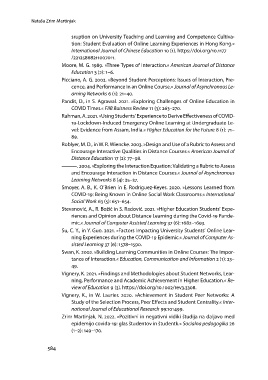Page 584 - Istenič Andreja, Gačnik Mateja, Horvat Barbara, Kukanja Gabrijelčič Mojca, Kiswarday Vanja Riccarda, Lebeničnik Maja, Mezgec Maja, Volk Marina. Ur. 2023. Vzgoja in izobraževanje med preteklostjo in prihodnostjo. Koper: Založba Univerze na Primorskem
P. 584
aša Zrim Martinjak
sruption on University Teaching and Learning and Competence Cultiva-
tion: Student Evaluation of Online Learning Experiences in Hong Kong.«
International Journal of Chinese Education 10 (1). https://doi.org/10.1177
/22125868211007011.
Moore, M. G. 1989. »Three Types of Interaction.« American Journal of Distance
Education 3 (2): 1–6.
Picciano, A. G. 2002. »Beyond Student Perceptions: Issues of Interaction, Pre-
cence, and Performance in an Online Course.« Journal of Asynchronous Le-
arning Networks 6 (1): 21–40.
Pandit, D., in S. Agrawal. 2021. »Exploring Challenges of Online Education in
COVID Times.« FIIB Buisness Review 11 (3): 263–270.
Rahman, A. 2021. »Using Students’ Experience to Derive Effectiveness of COVID-
19-Lockdown-Induced Emergency Online Learning at Undergraduate Le-
vel: Evidence from Assam, India.« Higher Education for the Future 8 (1): 71–
89.
Roblyer, M. D., in W. R. Wiencke. 2003. »Design and Use of a Rubric to Assess and
Encourage Interactive Qualities in Distance Courses.« American Journal of
Distance Education 17 (2): 77–98.
———. 2004. »Exploring the Interaction Equation: Validating a Rubric to Assess
and Encourage Interaction in Distance Courses.« Journal of Asynchronous
Learning Networks 8 (4): 25–37.
Smoyer, A. B., K. O’Brien in E. Rodriguez-Keyes. 2020. »Lessons Learned from
COVID-19: Being Known in Online Social Work Classrooms.« International
Social Work 63 (5): 651–654.
Stevanović, A., R. Božić in S. Radović. 2021. »Higher Education Students’ Expe-
riences and Opinion about Distance Learning during the Covid-19 Pande-
mic.« Journal of Computer Assisted Learning 37 (6): 1682–1693.
Su, C. Y., in Y. Guo. 2021. »Factors Impacting University Students’ Online Lear-
ning Experiences during the COVID-19 Epidemic.« Journal of Computer As-
sisted Learning 37 (6): 1578–1590.
Swan, K. 2002. »Building Learning Communities in Online Courses: The Impor-
tance of Interaction.« Education, Communication and Information 2 (1): 23–
49.
Vignery, K. 2021. »Findings and Methodologies about Student Networks, Lear-
ning, Performance and Academic Achievement in Higher Education.« Re-
view of Education 9 (3). https://doi.org/10.1002/rev3.3308.
Vignery, K., in W. Laurier. 2020. »Achievement in Student Peer Networks: A
Study of the Selection Process, Peer Effects and Student Centrality.« Inter-
national Journal of Educational Research 99:101499.
Zrim Martinjak, N. 2022. »Pozitivni in negativni vidiki študija na daljavo med
epidemijo covida-19: glas študentov in študentk.« Socialna pedagogika 26
(1–2): 149–170.
584
sruption on University Teaching and Learning and Competence Cultiva-
tion: Student Evaluation of Online Learning Experiences in Hong Kong.«
International Journal of Chinese Education 10 (1). https://doi.org/10.1177
/22125868211007011.
Moore, M. G. 1989. »Three Types of Interaction.« American Journal of Distance
Education 3 (2): 1–6.
Picciano, A. G. 2002. »Beyond Student Perceptions: Issues of Interaction, Pre-
cence, and Performance in an Online Course.« Journal of Asynchronous Le-
arning Networks 6 (1): 21–40.
Pandit, D., in S. Agrawal. 2021. »Exploring Challenges of Online Education in
COVID Times.« FIIB Buisness Review 11 (3): 263–270.
Rahman, A. 2021. »Using Students’ Experience to Derive Effectiveness of COVID-
19-Lockdown-Induced Emergency Online Learning at Undergraduate Le-
vel: Evidence from Assam, India.« Higher Education for the Future 8 (1): 71–
89.
Roblyer, M. D., in W. R. Wiencke. 2003. »Design and Use of a Rubric to Assess and
Encourage Interactive Qualities in Distance Courses.« American Journal of
Distance Education 17 (2): 77–98.
———. 2004. »Exploring the Interaction Equation: Validating a Rubric to Assess
and Encourage Interaction in Distance Courses.« Journal of Asynchronous
Learning Networks 8 (4): 25–37.
Smoyer, A. B., K. O’Brien in E. Rodriguez-Keyes. 2020. »Lessons Learned from
COVID-19: Being Known in Online Social Work Classrooms.« International
Social Work 63 (5): 651–654.
Stevanović, A., R. Božić in S. Radović. 2021. »Higher Education Students’ Expe-
riences and Opinion about Distance Learning during the Covid-19 Pande-
mic.« Journal of Computer Assisted Learning 37 (6): 1682–1693.
Su, C. Y., in Y. Guo. 2021. »Factors Impacting University Students’ Online Lear-
ning Experiences during the COVID-19 Epidemic.« Journal of Computer As-
sisted Learning 37 (6): 1578–1590.
Swan, K. 2002. »Building Learning Communities in Online Courses: The Impor-
tance of Interaction.« Education, Communication and Information 2 (1): 23–
49.
Vignery, K. 2021. »Findings and Methodologies about Student Networks, Lear-
ning, Performance and Academic Achievement in Higher Education.« Re-
view of Education 9 (3). https://doi.org/10.1002/rev3.3308.
Vignery, K., in W. Laurier. 2020. »Achievement in Student Peer Networks: A
Study of the Selection Process, Peer Effects and Student Centrality.« Inter-
national Journal of Educational Research 99:101499.
Zrim Martinjak, N. 2022. »Pozitivni in negativni vidiki študija na daljavo med
epidemijo covida-19: glas študentov in študentk.« Socialna pedagogika 26
(1–2): 149–170.
584


